Biology
Let?s do a demonstration. Borrow a peppermint lifesaver from a friend (well, not borrow really - you?re not going to give it back). Place it between your teeth, so you can close your lips around it and suck air in through the hole (this will be the control for our experiment).
- Cold Receptors Come In From The Cold
Biology concepts ? thermosensing, cool sensing, allergy, cross-reactivity, cold allergy, sperm maturation, acrosome reaction, opiate withdrawal You can be allergic to things that touch your skin ? like poison ivy, things injected, like bee venom,...
- The Cold Cure All
Biology concepts ? thermoregulation, TRPM8, TRPV1, heat sensing, cool sensing, vasoconstriction, nasal resistance, viral cold The common cold. The red nose is from irritation from tissue and inflammation. The medicines are to treat the symptoms....
- Chili Peppers Run Hot And Cold
Biology concepts ? obesity, brown adipose tissue, agonist/antagonist, protective hypothermia, hyperthermia, reactive oxygen species, ischemia, hypoxia When The Wizard of Oz was released in 1939, it just barely turned a profit. The '39 version was...
- Capsaicin ? Adding To Or Taking Your Pain
Biology concepts ? hyperalgesia, allodynia, analgesia, sensitization, potentiation, desensitization, habituation, burning mouth syndrome Apparently this is how people shovel snow in the cold climates. I agree with the form; always bend with your...
- Maybe We Do Taste The Burn
Biology concepts ? capsaicin, TRPV1, heat sensing, thermoregulation, taste, ligand Eating spicy food can seem like having fire in your mouth. Interestingly enough, some people do that. Fire eaters do not use ?cold flames? or anything in their mouths...
Biology
Cold Keeps You Warm
Biology concepts ? thermoregulation, TRPM8, vasoconstriction, brown adipose tissue, agonists/antagonists
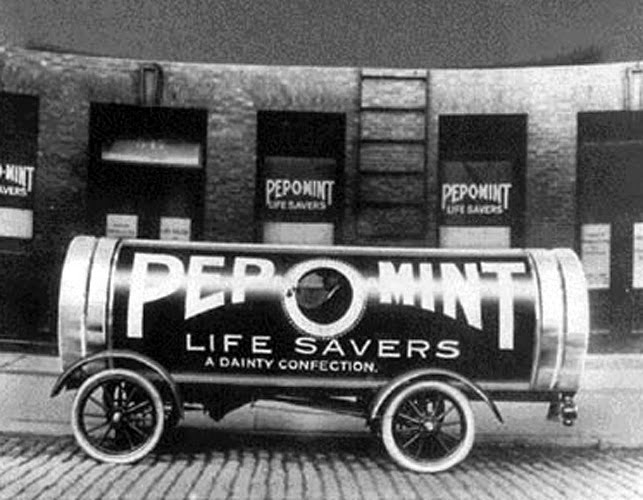 |
| Pep-O Mint was the first Lifesaver flavor, invented in 1912. This was followed quickly by the Lifesaver car in 1918. Built on a Dodge truck chassis, the important word was dodge, since the car didn?t have a windshield and the driver had to stick his head out the side window to see ahead. |
Now put the candy in your mouth like normal and suck on it for a minute or two ? don?t chew it up. Swallow to get the saliva out of your mouth and take out the candy. Now take in a long slow breath of air. How does it feel? Did the room get colder in the last two minutes?
If you are like most people, the air feels colder in your mouth now that you've eaten menthol (peppermint). Just like capsaicin can make hot things seem hotter via TRPV1, the cold sensing channel we talked about last week, TRPM8, can make room temperature air seem colder.
The TRPM8 cold sensing ion channel is important for keeping our body temperature in a normal range. Just like TRPV1 senses when we are too warm and initiates cooling mechanisms, TRPM8 tells us we are cold and institutes procedures to make us warmer. One way is to stimulate vasoconstriction, so less heat is lost from the blood through our skin. I?m sure you have noticed that your skin is paler when you are out in the cold. This is from vasoconstriction limiting the amount of blood moving into the surface vessels.
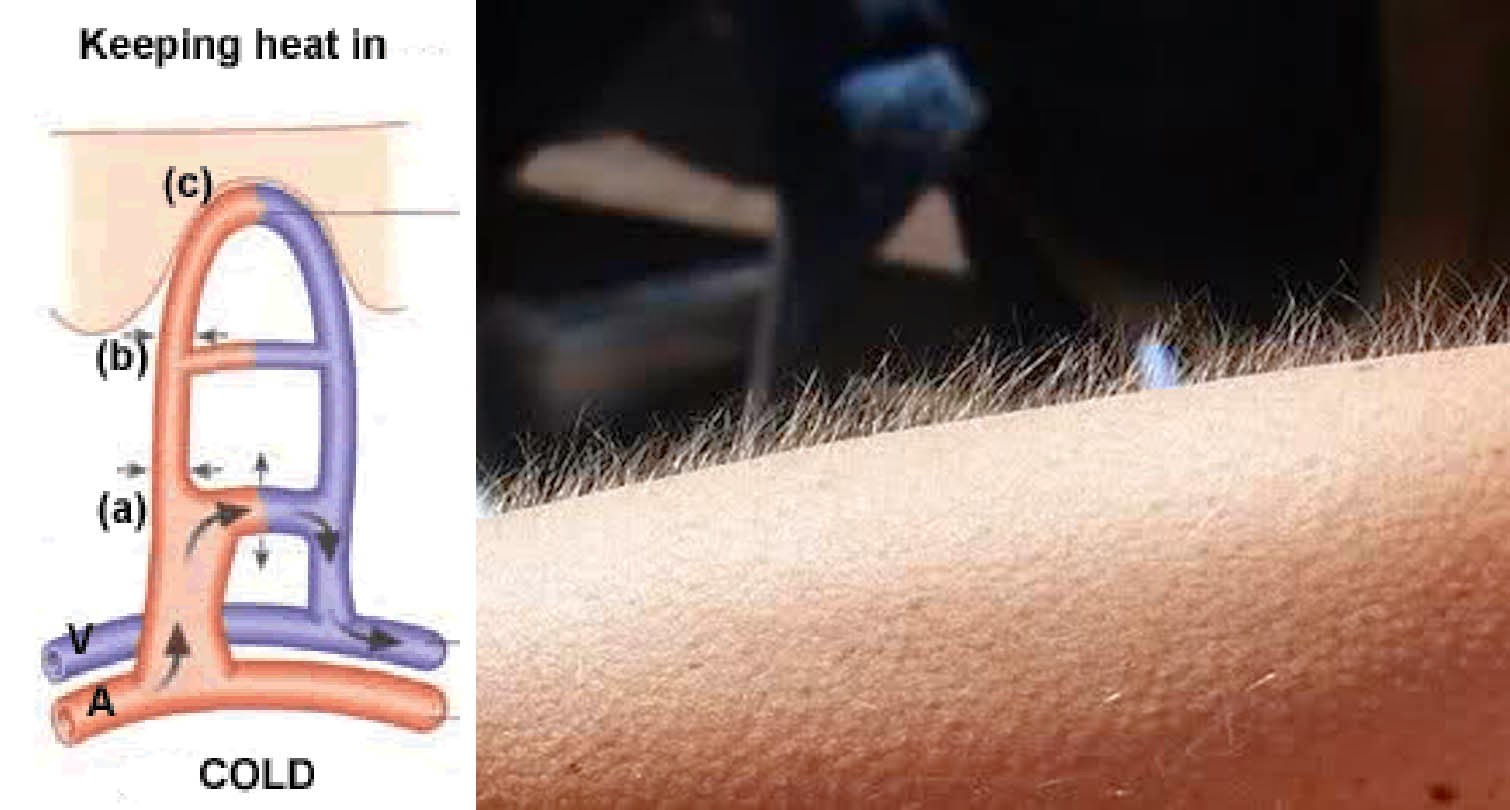 |
| When your core temperature varies from your skin temperature by too much, TRPM8 will institute heat conserving and/or generating mechanisms. For heat conservation, more of the blood (left cartoon) that goes the skin can be shunted through the capillaries before it gets to the surface. This helps reduce the amount of heat loss via radiation of the heat in the blood. On the right is the effect of the arrector pili muscles. When cold, they contract and raise the hairs, trap air, and therefore trap body heat against the skin so less heat is loss. The contraction also mounds up the skin ? goosebumps. |
TRPM8 can also stimulate shivering and the burning of fat to generate warmth. Through the sensations and reactions of TRPV1 and TRPM8, animals learn to maintain a more or less constant body temperature, seeking out temperatures that are good for physiology and avoiding temperatures that would change their core temperature by too much. This was shown in a series of studies described in a 2013 paper, where mice without temperature sensing receptors TRPV1 and/or TRPM8 would not avoid hot or cold temperatures and were prone to hyperthermia and or hypothermia.
So how does the TRPM8 channel sense cold? We saw that with TRPV1 the heat induced a conformation change that caused the channel to open and calcium to flow in and start a neural action potential. Could cold induce a conformation change as well? Maybe. What was seen in a 2011 study was that TRPM8 neurons started firing when the temperature dropped to 28.4?C (83 ?F). As the temperature dropped, the neurons would fire more and more strongly, so it could act as a thermostat.
When the temperature dropped severely (to 10?C) the core temperature changed little, but skin temperature dropped considerably. The TRPM8 thermostat was targeted to keeping the organs and brain warm, not the skin. It accomplishes this by diverting heat via the blood away from the skin. A 2012 study showed that TRPM8 antagonists brought a systemic hypothermia, but repeated use of the antagonist reduced the magnitude of the temperature drop ? so unlike most TRPV1antagonists (that bring bad hyperthermia), TRPM8 antagonists might be helpful in medicine.
But this still doesn?t answer the questions as to how TRPM8 can detect cool temperatures. It may or may not be a conformation change, but what does occur is an alteration in the apparenttemperature threshold of the neuron. The cold temperature should inhibit firing (cold slows metabolism and chemical activity), but here it increases the metabolism and biochemical activities. TRPM8 makes the neuron seem warmer so that the firing is easier, and this transfers information that the area is in fact colder! That?s an exception.
It seems that TRPM8 can stimulate the burning of fat to produce heat. We talked about this before with capsaicin as well. Brown adipose tissue has more mitochondria and more of a protein called UCP1 (uncoupling protein). UCP separates mitochondrial energy burning from ATP production; all the energy goes to making heat.
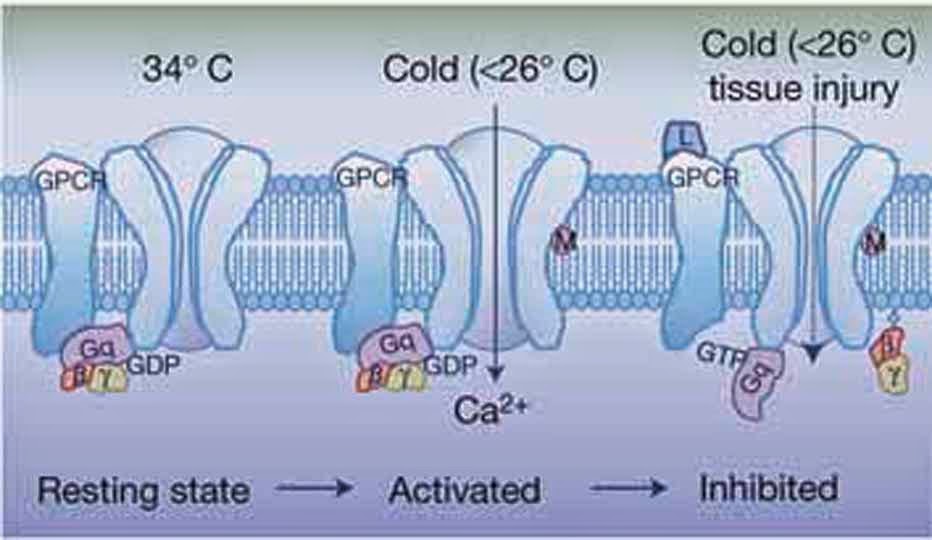 |
| We don?t yet know how cold activates TRPM8. In warmth, the channel is closed. With cooler temperature or menthol (M), the channel is open, but we don?t know if cold achieves this by a conformation change. If really cold, the regulatory proteins break away and the channel can?t work. So TRPM8 is active in a range of temperatures. |
However it manages the feat, TRPM8 is important for keeping mammals warm. It might even help you lose weight. Chronic cold stimulates TRPM8 all the time, and this ramps up your heat production. A 2012 study showed that for mice, chronic cold could actually prevent them from becoming obese.
Heat production takes energy, and burning more energy helps you lose weight. But there is an important balancing act at work here. Our fat also protects us against losing too much heat in the cold. Look at whales, they have a layer of blubber all over their body to insulate them from the cold water. It has been shown that people with an even layer of fat all over their body make good cold weather swimmers, like Lynne Cox, who swam from her perfectly good boat to the shores of Antarctica and across the Bering Strait in 4?C (40?F) water.
On the other hand, bactrian camels keep their fat limited to two humps (one for dromedaries) in order to prevent against having too much insulation in their desert environment. Camels need to be able to dissipate lots of heat. And no, the humps aren?t for storing water! Remember we said that one of the great things about fat is that you can store lots of energy in a small space precisely because can be stored without water.
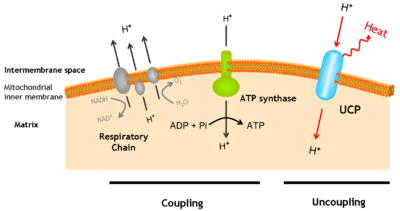 |
| In brown adipose tissue, there are ATP synthase proteins (for making ATP) and uncoupling proteins (for generating heat) in the inner mitochondrial membrane. When cold, the number of UCP proteins is increased, as is the number of mitochondria. About 65% of the energy of the proto gradient formed by the respiratory chain can be converted to ATP by the ATP synthase. But using the UCP to allow protons back in means that 100% of the energy is changed to heat, no ATP is made. |
A 2014 study showed that chronic cold makes brown fat AND white fat upregulate UCP and generate more mitochondria. It makes white fat more like brown fat and this means that more fat is burned. In mice, this chronic cold is enough to keep them from becoming obese, even on a high glucose diet. So if you want to stay skinny, turn your thermostat way down all year round.
The study that showed that chronic cold kept mice from getting fat wasn?t as cruel as it may sound. They didn?t keep the mice at cold temperature all the time, they used a chemical that could mimic the cold and make the TRPM8 channels fire all the time. What did they use? Menthol.
With TRPM8, menthol (in mints) and some other chemicals open the ion channels just as cool/cold temperatures would, and our brains trick us into thinking the mouth or skin is colder than it really is. That?s what is behind our lifesaver trick at the beginning of the post. The air wasn?t any colder; your brain makes you think it was.
Take oil of wintergreen in BenGay for example. We showed that it was a TRPV1 agonist, so it could induce analgesia by counter irritation. But it is also a TRPM8 agonist. In the oral cavity at lower concentrations than used in BenGay, it activates TRPM8 and desensitizes TRPV1. The lifesaver trick will work with peppermint, spearmint, and wintergreen flavors; they all activate TRPM8.
Pogorzala LA, Mishra SK, & Hoon MA (2013). The cellular code for mammalian thermosensation. The Journal of neuroscience : the official journal of the Society for Neuroscience, 33 (13), 5533-41 PMID: 23536068
Rossato M, Granzotto M, Macchi V, Porzionato A, Petrelli L, Calcagno A, Vencato J, De Stefani D, Silvestrin V, Rizzuto R, Bassetto F, De Caro R, & Vettor R (2014). Human white adipocytes express the cold receptor TRPM8 which activation induces UCP1 expression, mitochondrial activation and heat production. Molecular and cellular endocrinology, 383 (1-2), 137-46 PMID: 24342393
Ma S, Yu H, Zhao Z, Luo Z, Chen J, Ni Y, Jin R, Ma L, Wang P, Zhu Z, Li L, Zhong J, Liu D, Nilius B, & Zhu Z (2012). Activation of the cold-sensing TRPM8 channel triggers UCP1-dependent thermogenesis and prevents obesity. Journal of molecular cell biology, 4 (2), 88-96 PMID: 22241835
Selescu T, Ciobanu AC, Dobre C, Reid G, & Babes A (2013). Camphor activates and sensitizes transient receptor potential melastatin 8 (TRPM8) to cooling and icilin. Chemical senses, 38 (7), 563-75 PMID: 23828908
This is a good place to point out the similar exception for TRPV1 and TRPM8. They are both proteins that can be activated by both environmental factors and by chemicals. We saw that TRPV1 is activated by capsaicin and other chemicals. The opening of the channel and firing of the neurons in response to these chemicals was interpreted exactly the same as if the neurons were exposed to damaging heat.
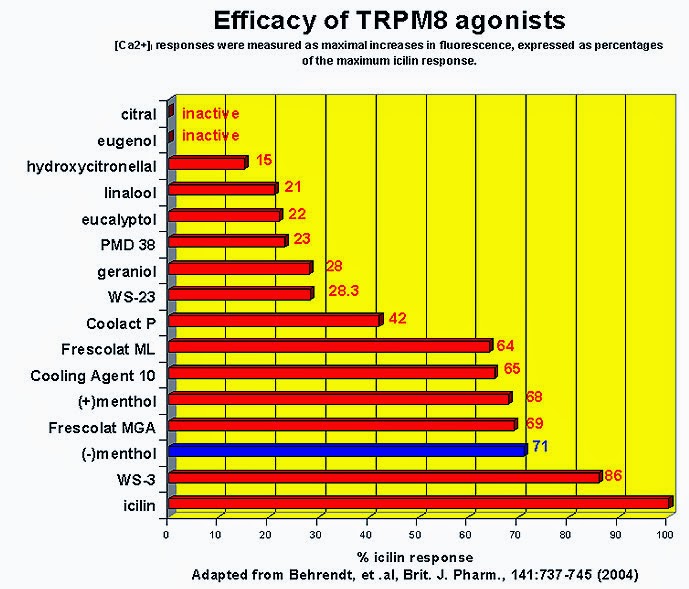 |
| There are many agonists for TRPM8, similar to TRPV1. In fact, some things that activate TRPM8 also activate TRPV1. An interesting one is the synthetic agonist called icilin. It is thousands of time more active on TRPM8 than cool temperatures. However, it binds to TRPM8 in a completely different way as compared to menthol and cool temperatures. |
Menthol is a terpene alkaloid contained in plants of the genus Mentha (mint, from the Greek mintha). This genus includes 25 species of aromatic herbs, such as peppermint, spearmint, and pennyroyals. Most mints can be and are used in making foods and drinks, but the pennyroyals also contain toxic compounds that will induce liver failure and kill you.
At low concentrations in the mouth or on skin, menthol produces a pleasant cooling sensation, but higher concentrations produce burning, irritation and pain (this has to do with how it activates TRPV1, TRPV3, TRPM8, and TRPA1, depending on the concentration).
In the oral cavity, a small amount of menthol actually desensitizes TRPV1 activation by heat and capsaicin, so chili peppers might not seem so spicy. Biochemical evidence shows that menthol sparks a release of glutamate from neurons. But an increase in glutamate neurotransmitter can actually stop the type C nociceptive neurons from firing (an inhibitory neurotransmitter in this case).
 |
| Pennyroyal is a member of the mentha genus (left). It, like many plants (right image is orange mint), has been used in medicine. It can be ground and drunk with water to settle a sick tummy or to induce perspiration. However, pennyroyal has to be used carefully. In addition to menthol, it contains a chemical called pulegone. Too much pulegone and here come the seizures, organ failure and death. Don?t confuse the two mints. |
At this same time, menthol (or other TRPM8 agonists) will sensitize TRPM8 receptors, the combination of these two results means that sucking in air after a wintergreen or peppermint candy will make the air seem colder, but might also make a hot cup of coffee seem cold as well.
I think the only way to resolve these ideas is to start a controlled experiment. What do you predict would happen if you froze a chili pepper and then took a bite? How about eating peppermint laced with capsaicin, or a strong peppermint flavored tea that has been heated to near boiling? Who will win out, TRPM8 or TRPV1?
It may not be so easy to figure out. The agonists and antagonists of the TRPs can have effects on multiple receptors and the effects can be different at different concentrations. Menthol sensitizes TRPM8, but if the temperature is above 37? C (98? F) it actually makes TRPV3, a heat sensor, more active (2006).
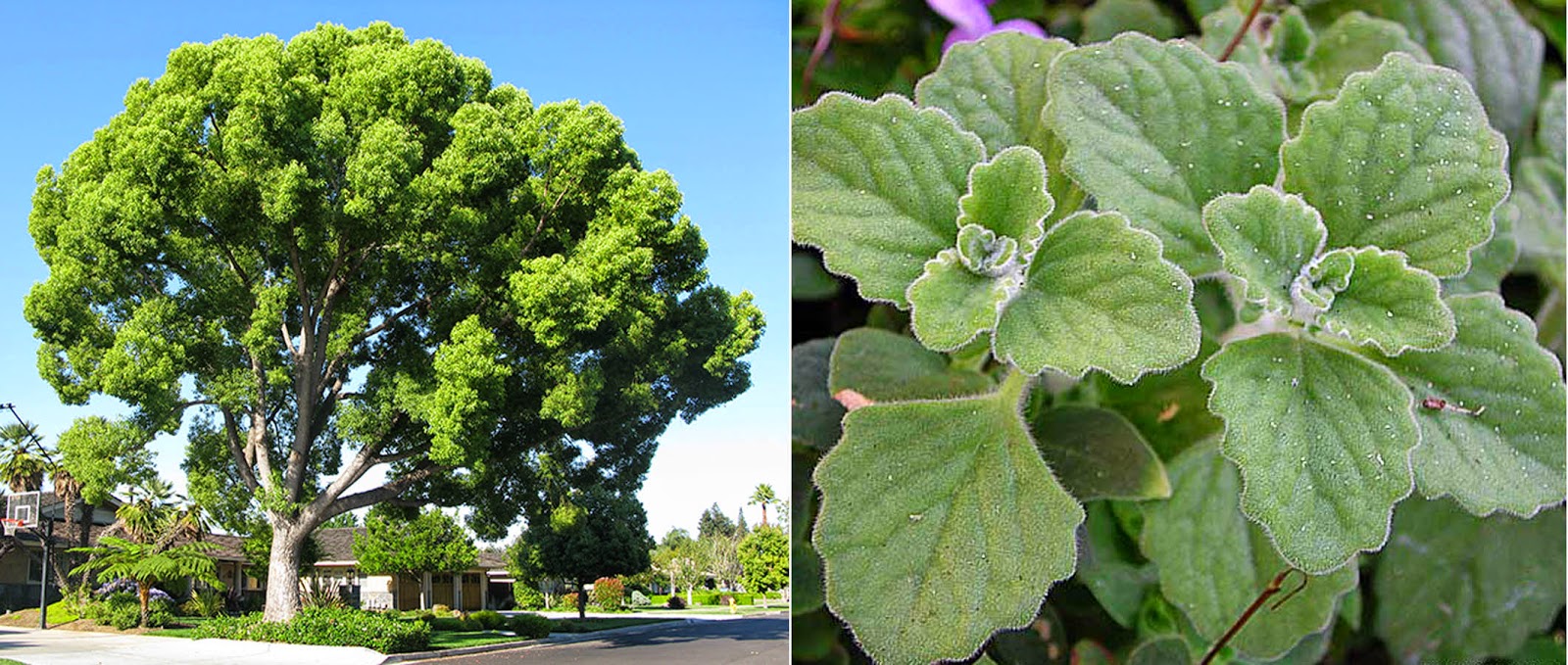 |
| Camphor comes from some species of laurel trees (left), as well as from some herbs of the mint family, like camphor basil (right). Dried rosemary leaves are up to 20% camphor. Camphor has been used for many things, including as a flavoring in asian sweets, an analgesic, an insect repellent, and a rust proofing agent. I find it hard to rectify those uses with one another. |
And then there?s camphor. Like menthol, camphor is terpenoid chemical. Camphor can make things seem cool (by activating and sensitizing TRPM8), but it?s more complicated. It actually potentiates both heat and cold sensations. A 2013 study shows that it can sensitize or potentiate TRPV1 (painful hot) and TRPM8 (non-painful cool). Camphor can even activate the noxious cold sensor TRPA1 that we will talk about in a couple of posts. This means that it can be analgesic or painful, warming and cooling.
It becomes even more confusing when you realize that camphor activates TRPM8, just like menthol, but can inhibit the activation of TRPM8 by menthol. Weird, right? Well, consider this ? Vick's VapoRub contains menthol and camphor as its active ingredients. Next week, we'll investigate how they can work together to open your nose and make you feel both warm and fuzzy while they cool and invigorate you at the same time.
For more information or classroom activities, see:
Thermoregulation ?
http://beyondcoldwaterbootcamp.com/en/thermo-regulation
http://www.unm.edu/~lkravitz/Article%20folder/thermoregulation.html
http://dwb.unl.edu/teacher/nsf/c01/c01links/www.science.mcmaster.ca/biology/4s03/thermoregulation.html
https://worldofbiology.wikispaces.com/biol+2+classroom+presentations
http://www.pbslearningmedia.org/resource/lsps07.sci.life.reg.heatexchange/blood-flow-and-thermoregulation/
http://www.google.com/url?sa=t&rct=j&q=&esrc=s&source=web&cd=5&ved=0CDwQFjAE&url=http%3A%2F%2Fbio.classes.ucsc.edu%2Fbio131%2FThometz%2520Website%2F9%2520-%2520Thermoregulation%2520Lab%25202012.pdf&ei=zSIzU6SuFqPEyQGZ4oD4CA&usg=AFQjCNERS9ye-sPF7qZM-dJHUsFPQ031Tw&sig2=xLwl_fcQ3rIxKcZiLictmw
http://www.life.umd.edu/classroom/bsci338m/Lectures/Temperature.html
https://www.khanacademy.org/science/mcat/organ-systems/muscular-system/v/thermoregulation-by-muscles
https://www.youtube.com/watch?v=kg7QdpOug2Y
http://www.nsta.org/publications/news/story.aspx?id=53687
http://www.google.com/url?sa=t&rct=j&q=&esrc=s&source=web&cd=16&ved=0CEgQFjAFOAo&url=http%3A%2F%2Fwww.tarleton.edu%2F~jblevins%2Fexercise%2520physiology%2FSpring%252009%2Fpowers7_ppt_Chap12%2520%255BRead-Only%255D%2520%255BCompatibility%2520Mode%255D.pdf&ei=HSMzU-ToHaSHygGerwE&usg=AFQjCNHxnlMTdNoOKd1p9lJrSyv6yew6Jg&sig2=fsvfEpvq9j0LTxOVaSYQwQ
http://www.studyblue.com/notes/note/n/ch-40-hwpdf/file/9213703
http://vce-unit1and2biology.wikispaces.com/thermoregulation
http://en.wikioffuture.org/Dissertation_Research:_Olfactory_Modulation_of_Thermoregulation_and_Flight_in_Moths
http://hyperphysics.phy-astr.gsu.edu/hbase/thermo/heatreg.html
https://www.youtube.com/watch?v=TSUCdLkI474
http://people.seas.harvard.edu/~jones/cscie129/pages/health/thermreg.htm
https://www.stanford.edu/group/stanfordbirds/text/essays/Temperature_Regulation.html
https://www.mdc-berlin.de/26954638/de/research/research_teams/temperature_detection_and_thermoregulation/Research?cntx=40550329
- Cold Receptors Come In From The Cold
Biology concepts ? thermosensing, cool sensing, allergy, cross-reactivity, cold allergy, sperm maturation, acrosome reaction, opiate withdrawal You can be allergic to things that touch your skin ? like poison ivy, things injected, like bee venom,...
- The Cold Cure All
Biology concepts ? thermoregulation, TRPM8, TRPV1, heat sensing, cool sensing, vasoconstriction, nasal resistance, viral cold The common cold. The red nose is from irritation from tissue and inflammation. The medicines are to treat the symptoms....
- Chili Peppers Run Hot And Cold
Biology concepts ? obesity, brown adipose tissue, agonist/antagonist, protective hypothermia, hyperthermia, reactive oxygen species, ischemia, hypoxia When The Wizard of Oz was released in 1939, it just barely turned a profit. The '39 version was...
- Capsaicin ? Adding To Or Taking Your Pain
Biology concepts ? hyperalgesia, allodynia, analgesia, sensitization, potentiation, desensitization, habituation, burning mouth syndrome Apparently this is how people shovel snow in the cold climates. I agree with the form; always bend with your...
- Maybe We Do Taste The Burn
Biology concepts ? capsaicin, TRPV1, heat sensing, thermoregulation, taste, ligand Eating spicy food can seem like having fire in your mouth. Interestingly enough, some people do that. Fire eaters do not use ?cold flames? or anything in their mouths...
